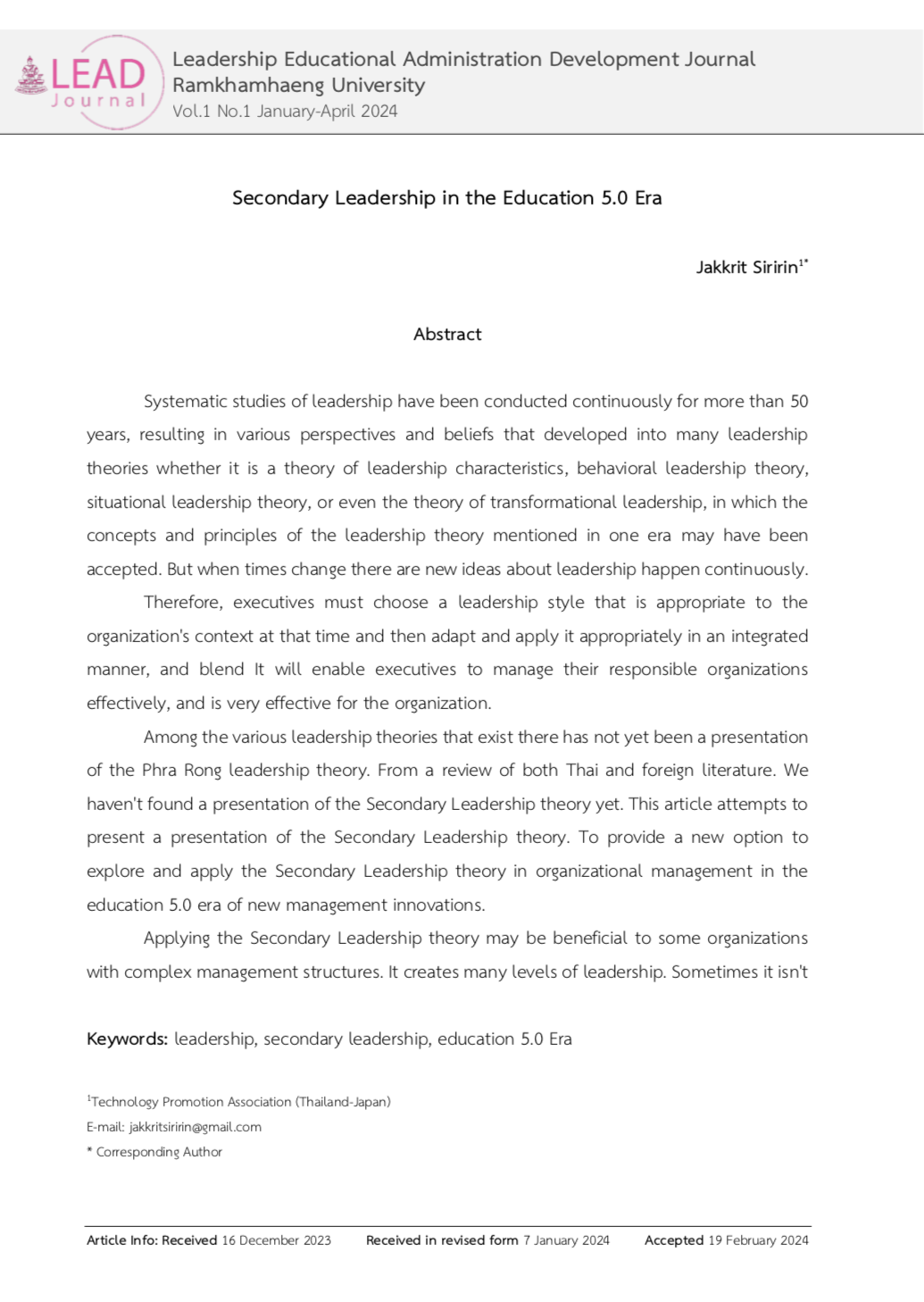Secondary Leadership in the Education 5.0 Era
Main Article Content
Abstract
Systematic studies of leadership have been conducted continuously for more than 50 years, resulting in various perspectives and beliefs. that developed into many leadership theories whether it is a theory of leadership characteristics behavioral leadership theory situational leadership theory or even the theory of transformational leadership, in which the concepts and principles of the leadership theory mentioned in one era may have been accepted. But when times change there are new ideas about leadership happen continuously. Therefore, executives must choose a leadership style that is appropriate to the organization's context at that time and then adapt and apply it appropriately in an integrated manner. and blend It will enable executives to manage their responsible organizations effectively. and is very effective for the organization. Among the various leadership theories that exist there has not yet been a presentation of the Phra Rong leadership theory. From a review of both Thai and foreign literature. Haven't found a presentation of the Secondary Leadership theory yet. This article attempts to present a presentation of the Secondary Leadership theory. To provide a new option to explore and apply the Secondary Leadership theory in organizational management in the education 5.0 era of new management innovations. Applying the Secondary Leadership theory may be beneficial to some organizations with complex management structures. It creates many levels of leadership. Sometimes it isn't easy to promote someone into a leadership position. Maintaining a monk-type leader may be appropriate and beneficial in some situations. and in some organizations for flexibility management.
Downloads
Article Details

This work is licensed under a Creative Commons Attribution-NonCommercial-NoDerivatives 4.0 International License.
แนวคิดและข้อเสนอแนะที่นำเสนอในบทความของ LEAD เป็นแนวคิดที่มาจากผู้เขียน หากมีความผิดพลาดใด ๆ ผู้เขียนเป็นผู้รับผิดชอบแต่เพียงผู้เดียว
ทั้งนี้ บรรณาธิการ กองบรรณาธิการ และคณะกรรมการหน่วยจัดทำวารสาร LEAD จะไม่ก้าวก่ายความมั่นคงในหลักการตามความคิดของผู้เขียน
ดังนั้น บรรณาธิการ กองบรรณาธิการ คณะกรรมการหน่วยจัดทำวารสาร และมหาวิทยาลัย จะไม่รับผิดชอบใด ๆ จากผลที่เกิดขึ้นจากการนำเสนอแนวคิด และข้อเสนอแนะของผู้แต่งที่เผยแพร่ในวารสาร LEAD
References
Bass, B. M. and Avolio, B. J. (1999). Improving Organizational Effectiveness through Transformational Leadership. Thousand Oaks, CA: Sage.
Bass, B. M. and Riggio, R. E. (2006). Transformational leadership (2nd ed.). Lawrence Erlbaum Associates Publishers.
Burns, J. M. (1978). Leadership. New York: Harper & Row.
Kananurak, N. (2011). Leadership Role for Producing Professional Employees. Academic journal University of the Thai Chamber of Commerce, 31(1). 123-133.
Phongsriwat, S. (2013). Superior Leadership. Retrieved from http://suthep.crru.ac.th
Phothikun, P. (2007). Strategies for using Power in Organizations Effectively. Retrieved from www.moe.go.th


